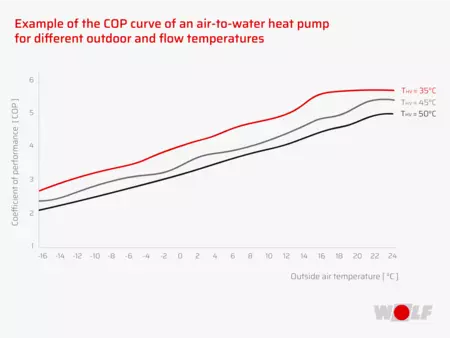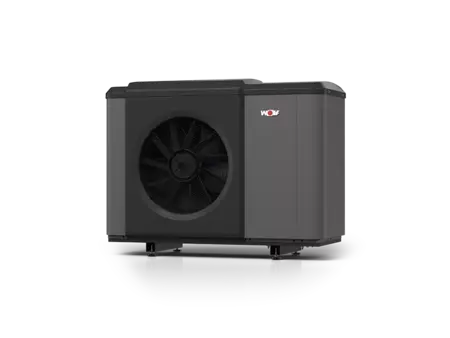
COP of heat pumps
The coefficient of performance for assessing efficiency
About 40% of homeowners choose a heat pump when building a new home. But it is also an attractive option for existing buildings, given the rising prices and other disadvantages of fossil fuels such as gas and oil. The outstanding efficiency of heat pumps is a crucial factor. The coefficient of performance (COP) enables us to compare different models of the same design more easily.
Why is the coefficient of performance important when buying a heat pump?
As heat pumps use freely available environmental heat, you only pay for the electricity used during operation (if you do not generate it yourself with a photovoltaic system).
It is crucial to know the COP of a heat pump so that you can judge how efficiently it works. This value is also a parameter that indicates the environmental friendliness of your heating system. The higher the coefficient of performance, the less electricity a heat pump consumes. This saves energy and also reduces CO2 emissions. Last but not least, you will also reduce your heating bills.
What exactly is the COP of a heat pump?
In a similar way to the seasonal performance factor (SPF), the COP of a heat pump is calculated by comparing the thermal energy it generates to the electricity it consumes. As it is a coefficient of performance, the COP always refers to a specific operating condition. This depends on two parameters in the heating system – the leaving water temperature of the heating system and the temperature of the available ambient energy. So this value is suitable for making broad comparisons of heat pump efficiency.
The SPF, on the other hand, takes a variety of reference values into account as operating conditions naturally change over the course of a year. This makes it a little more practical.
While the seasonal performance factor depends on many individual parameters and is not listed as a generalised figure, you can usually find the COP in the heat pump's data sheet.
The formula for calculating the COP of a heat pump is:
COP = generated heating energy (kWh) / electricity consumed to generate heat (kWh)
The resulting value is a coefficient of performance that can be used to evaluate the efficiency of a heat pump. It is helpful to know the COP, especially when comparing models made by different manufacturers. The higher the value, the greater the efficiency. And the lower the operating costs.
The following parameters affect the COP
Temperature of the heat source
Depending on the type of heat pump, the heat sources often have very different temperatures. They draw their energy either from the ground (geothermal), ambient air or groundwater. As an example, the temperature of groundwater remains at a certain temperature all year round while the temperature of ambient air changes from season to season.
This is important for the COP because the higher the outlet temperature of the heat source, the lower the power consumption of the heat pump.
Leaving water temperature of the heating system
The leaving water temperature also affects the efficiency and, accordingly, the COP. The lower the leaving water temperature, the less electricity the heat pump has to use. Correspondingly, the lower the leaving water temperature, the higher the COP of the heat pump.
This is also one of the main reasons why heat pumps work even better with radiant panel heating systems (such as underfloor heating) than with traditional radiators. Radiant panel heating systems only need a low leaving water temperature.
In new builds or well-insulated existing properties, a leaving water temperature of 30 to 35°C is usually sufficient. In all other older buildings, heat pumps with leaving water temperatures of up to 55°C can heat the interiors and generate hot water very efficiently.
Although the entering water temperature of the heating system likewise affects the COP, it is not usually separately listed. This is because it always has to be around 5°C below the leaving water temperature in line with EN 14511 and is automatically adjusted.

Understanding COP values stated by heat pump manufacturers
Manufacturers usually state the COP of a heat pump using a code that indicates the operating state in which the unit efficiency value was measured. As previously mentioned, the value depends on both the temperature of the heat source and the leaving water temperature of the heating system.
The following letters stand for different heat sources:
- A for Air
- B for Brine (brine / geothermal)
- W for Water (groundwater)
The codes are formed as follows:
Heat source code + Temperature in °C + Code for heat transfer medium + Leaving water temperature
Examples:
- A2W35 stands for an air-to-water heat pump whose heat source (air) has a temperature of 2°C and whose heat transfer medium (water) has a leaving water temperature of 35°C.
- B0W35 stands for a brine-to-water heat pump whose heat source (brine) has a temperature of 0°C and whose heat transfer medium (water) has a leaving water temperature of 35°C.
- W10W50 stands for a water-to-water heat pump whose heat source (groundwater) has a temperature of 10°C and whose heat transfer medium (water) has a leaving water temperature of 50°C.
Air-to-water heat pumps
Popular, efficient, flexible
The WOLF CHA monoblock heat pump is positively unobtrusive so will blend in with the overall design of your home and can be installed in the garden, out on the patio or mounted on the outside wall – all with an impressive COP of 4.65.

Reference values for choosing a heat pump with a good COP
When reading the manufacturer's COP data on the data sheet of a heat pump, you can rank the coefficient of performance based on the values below:
- A2W35 air-to-water heat pumps should have a COP of at least 4
- B0W35 brine-to-water heat pumps should have a COP of at least 4.5
- W10W35 water-to-water heat pumps should have a COP of at least 5.5
As mentioned above, it is favourable for a heat pump to have a high COP. However, you must not forget that the coefficient always refers only to a strictly defined operating state that depends on the temperature of the heating system. Any deviations from these values have a corresponding effect on the COP.
Can heat pumps be compared on the basis of their COP?
As the environmental conditions can vary greatly during operation (and also change over the course of a year), the COP is not a suitable basis for comparing different types of heat pumps. You should refer to the SPF for this purpose. However, when it comes to making a direct comparison of similar heat pumps under identical operating conditions, the COP is a very good baseline for comparing efficiency.
How do you rate the efficiency of your heat pump?
Even though heat pumps mainly use free and emission-free environmental energy, they still need a little electricity to run properly. However, the following example shows you just how low the electricity consumption of a heat pump is:
- A detached house with heating requirements of 6000 kWh per year is heated by an air-to-water heat pump.
- The heat pump’s seasonal performance factor is 4.1.
- So the power required is 1463 kWh per year.
- If the electricity price starts at 30 cents per kilowatt hour, the heating costs start at 378 euros.
- If you run the heat pump using solar power generated on site, the cost of heating will drop even further.
So, compared to conventional heating systems, efficient heat pumps cut energy costs, produce less CO2 and produce no emissions.

Top advice from WOLF
If you are looking for an efficient heat pump for your existing building or a new build, you should seek in-depth advice. Correct dimensioning and careful planning are crucial for efficient heating. The experts at WOLF will be happy to help you.
Using the COP to compare heat pumps of the same type
For both professionals and consumers, the COP is especially important when comparing the efficiency of different models of a particular type of heat pump. The higher the value, the lower the electricity consumption and the greater the efficiency of the heat pump. However, different types of heat pumps cannot be compared using the COP, as this coefficient of performance always references predefined operating conditions. The seasonal performance factor, or SPF, can be used to make a more meaningful comparison if you are comparing different types of heat pump systems.


